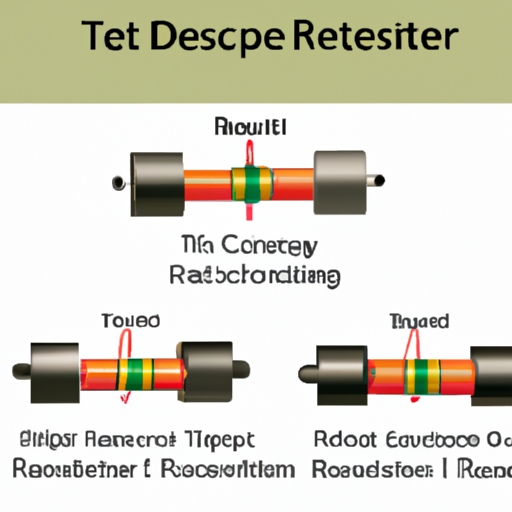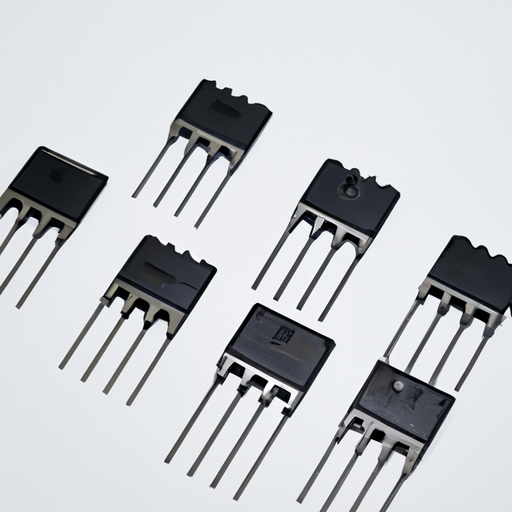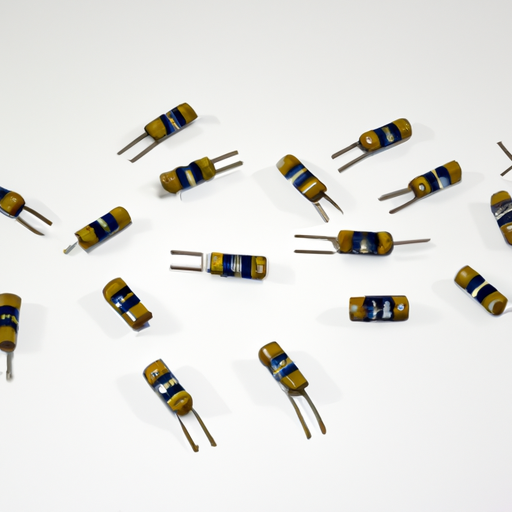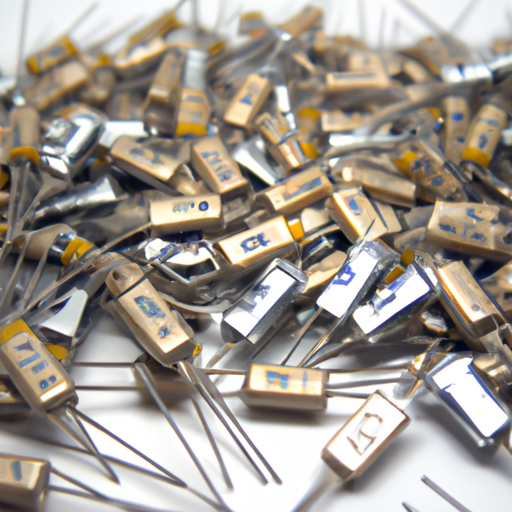Fixed resistor product training considerations
Fixed Resistor Product Training Considerations
I. Introduction
A. Definition of Fixed Resistors
Fixed resistors are passive electronic components that provide a specific resistance value in a circuit. Unlike variable resistors, which can be adjusted to change their resistance, fixed resistors maintain a constant resistance regardless of the voltage or current passing through them. This stability makes them essential in various electronic applications.
B. Importance of Fixed Resistors in Electronic Circuits
Fixed resistors play a crucial role in electronic circuits by controlling current flow, dividing voltages, and setting bias points for active components. Their reliability and predictability are vital for the proper functioning of electronic devices, from simple circuits to complex systems.
C. Purpose of the Training Document
This training document aims to provide a comprehensive understanding of fixed resistors, including their types, specifications, applications, selection criteria, testing methods, common issues, and best practices for handling and storage. By the end of this training, participants will be equipped with the knowledge necessary to effectively work with fixed resistors in various electronic applications.
II. Overview of Fixed Resistors
A. What is a Fixed Resistor?
1. Definition and Function
A fixed resistor is a component that resists the flow of electric current, creating a voltage drop across its terminals. The primary function of a fixed resistor is to limit current, divide voltages, and provide a reference point in circuits.
2. Types of Fixed Resistors
Fixed resistors come in various types, each with unique characteristics suited for specific applications:
Carbon Composition Resistors: Made from a mixture of carbon and a binding material, these resistors are known for their high energy absorption and ability to withstand high temperatures. However, they have a higher tolerance and noise level compared to other types.
Metal Film Resistors: These resistors are made by depositing a thin layer of metal onto a ceramic substrate. They offer better stability, lower noise, and tighter tolerances than carbon composition resistors, making them ideal for precision applications.
Wirewound Resistors: Constructed by winding a metal wire around a ceramic or fiberglass core, wirewound resistors can handle high power levels and are often used in power applications. However, they can be inductive, which may affect high-frequency performance.
Thin Film and Thick Film Resistors: Thin film resistors are made by depositing a very thin layer of resistive material, while thick film resistors use a thicker layer. Both types offer excellent stability and precision, with thin film resistors typically providing better performance in high-frequency applications.
B. Key Specifications
Understanding the key specifications of fixed resistors is essential for selecting the right component for a given application:
1. Resistance Value
The resistance value, measured in ohms (Ω), indicates how much the resistor opposes the flow of current. It is crucial to choose a resistor with the appropriate resistance value to ensure proper circuit functionality.
2. Tolerance
Tolerance refers to the allowable deviation from the specified resistance value, expressed as a percentage. A lower tolerance indicates a more precise resistor, which is essential in applications requiring high accuracy.
3. Power Rating
The power rating, measured in watts (W), indicates the maximum power the resistor can dissipate without overheating. Selecting a resistor with an appropriate power rating is vital to prevent damage and ensure reliability.
4. Temperature Coefficient
The temperature coefficient indicates how much the resistance value changes with temperature. A lower temperature coefficient is preferable for applications requiring stable performance across varying temperatures.
III. Applications of Fixed Resistors
Fixed resistors are used in a wide range of applications, including:
A. Role in Voltage Division
Fixed resistors are commonly used in voltage divider circuits, where they divide an input voltage into smaller output voltages. This is essential in applications such as sensor signal conditioning and reference voltage generation.
B. Current Limiting Applications
In LED circuits, fixed resistors are used to limit the current flowing through the LED, preventing damage and ensuring optimal brightness. This application is critical in various lighting and display technologies.
C. Signal Conditioning
Fixed resistors are integral to signal conditioning circuits, where they help filter and amplify signals. They are used in audio equipment, communication devices, and other electronic systems requiring signal processing.
D. Biasing Active Components
In amplifier circuits, fixed resistors are used to set the biasing conditions for transistors and operational amplifiers. Proper biasing ensures that these components operate within their optimal range, enhancing performance and stability.
E. Use in Filters and Oscillators
Fixed resistors are essential in designing filters and oscillators, where they work in conjunction with capacitors and inductors to shape frequency response and generate specific waveforms.
IV. Selection Criteria for Fixed Resistors
Choosing the right fixed resistor for a specific application involves several considerations:
A. Understanding Application Requirements
1. Resistance Value and Tolerance
Determine the required resistance value and tolerance based on the circuit design and performance specifications. This ensures that the resistor will function correctly within the intended application.
2. Power Dissipation Needs
Evaluate the power dissipation requirements of the circuit to select a resistor with an appropriate power rating. This prevents overheating and potential failure.
3. Environmental Considerations
Consider the operating environment, including temperature, humidity, and exposure to chemicals. Selecting resistors with suitable ratings for these conditions is essential for long-term reliability.
B. Evaluating Different Types of Resistors
1. Advantages and Disadvantages of Each Type
Each type of fixed resistor has its advantages and disadvantages. For example, while wirewound resistors can handle high power, they may not be suitable for high-frequency applications due to inductance. Understanding these characteristics helps in making informed decisions.
2. Cost Considerations
Cost is an important factor in resistor selection. While precision resistors may offer better performance, they can also be more expensive. Balancing performance requirements with budget constraints is crucial.
C. Importance of Manufacturer Specifications
Always refer to manufacturer datasheets for detailed specifications, including resistance values, tolerances, power ratings, and temperature coefficients. This information is vital for ensuring compatibility and reliability in circuit design.
V. Testing and Measurement
Testing fixed resistors is essential for ensuring their functionality and reliability. Here are some key aspects of testing:
A. Tools and Equipment for Testing Resistors
1. Multimeters
Multimeters are versatile tools used to measure resistance, voltage, and current. They are essential for testing fixed resistors in various applications.
2. LCR Meters
LCR meters are specialized instruments used to measure inductance (L), capacitance (C), and resistance (R). They provide more accurate measurements, especially for precision applications.
B. Methods for Measuring Resistance
1. Direct Measurement
Direct measurement involves using a multimeter to measure the resistance across the resistor terminals. This method is straightforward and effective for most applications.
2. Using Ohm's Law
Ohm's Law (V = IR) can also be used to calculate resistance by measuring the voltage across the resistor and the current flowing through it. This method is useful in circuit analysis.
C. Importance of Regular Testing in Quality Control
Regular testing of fixed resistors is essential in quality control processes to ensure that components meet specified tolerances and performance standards. This practice helps prevent failures in electronic devices.
VI. Common Issues and Troubleshooting
Understanding common issues related to fixed resistors can help in troubleshooting and maintaining circuit integrity:
A. Identifying Faulty Resistors
1. Symptoms of Failure
Common symptoms of faulty resistors include overheating, discoloration, or physical damage. These signs indicate that the resistor may no longer function correctly.
2. Testing Procedures
Testing procedures for identifying faulty resistors include measuring resistance with a multimeter and checking for continuity. If the resistance value is significantly different from the specified value, the resistor may be faulty.
B. Understanding Failure Modes
1. Overheating
Overheating can occur due to excessive power dissipation, leading to resistor failure. Proper power rating selection and circuit design can help prevent this issue.
2. Physical Damage
Physical damage can result from mechanical stress or environmental factors. Proper handling and storage practices are essential to minimize the risk of damage.
3. Drift in Resistance Value
Over time, resistors may experience drift in their resistance values due to aging or environmental factors. Regular testing can help identify these changes and ensure circuit reliability.
C. Preventative Measures
Implementing preventative measures, such as selecting appropriate resistors for specific applications and conducting regular testing, can help mitigate common issues and enhance circuit reliability.
VII. Best Practices for Handling and Storage
Proper handling and storage of fixed resistors are crucial for maintaining their performance and longevity:
A. Proper Handling Techniques
1. Avoiding Static Discharge
Static discharge can damage sensitive electronic components, including resistors. Using anti-static wrist straps and mats during handling can help prevent damage.
2. Minimizing Physical Stress
Avoid applying excessive force or bending resistors during installation. Proper handling techniques help prevent physical damage and ensure reliable performance.
B. Storage Conditions
1. Temperature and Humidity Control
Store resistors in controlled environments with stable temperature and humidity levels. Extreme conditions can affect resistor performance and longevity.
2. Packaging Considerations
Use appropriate packaging materials to protect resistors from physical damage and environmental factors during storage and transportation.
VIII. Conclusion
A. Recap of Key Points
Fixed resistors are essential components in electronic circuits, providing stability and reliability in various applications. Understanding their types, specifications, applications, and testing methods is crucial for effective circuit design and maintenance.
B. Importance of Proper Training and Knowledge
Proper training and knowledge about fixed resistors are vital for engineers, technicians, and anyone involved in electronic design and manufacturing. This understanding ensures that components are selected and used correctly, enhancing overall circuit performance.
C. Encouragement for Continuous Learning and Development
The field of electronics is constantly evolving, and continuous learning is essential for staying updated on new technologies and best practices. Engaging in ongoing education and training will help professionals remain competitive and effective in their roles.
IX. References
A. Suggested Reading Materials
- "The Art of Electronics" by Paul Horowitz and Winfield Hill
- "Electronic Components: A Complete Reference for Project Builders" by Delton T. Horn
B. Industry Standards and Guidelines
- IEC 60115: Fixed Resistors for Use in Electronic Equipment
- EIA-198: Standard for Fixed Resistors
C. Manufacturer Datasheets and Technical Resources
- Manufacturer websites often provide datasheets and technical resources for specific resistor models, offering detailed specifications and application notes.
---
This blog post provides a comprehensive overview of fixed resistors, covering essential aspects from basic definitions to practical applications and best practices. By understanding these components, professionals can enhance their skills and contribute to the success of their electronic projects.





